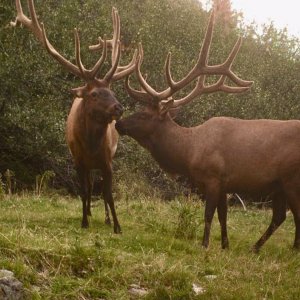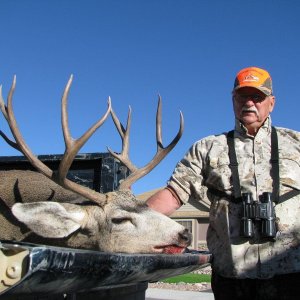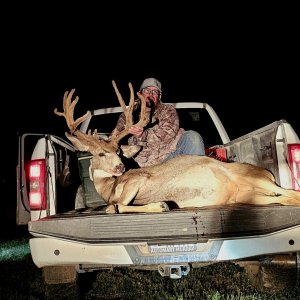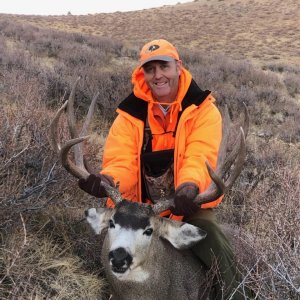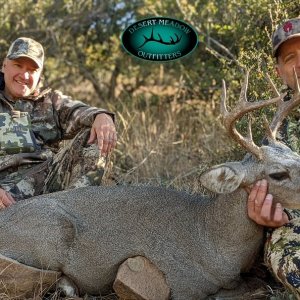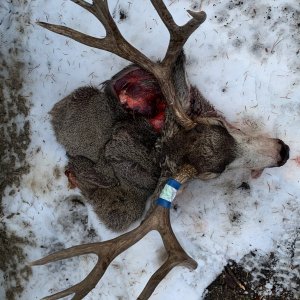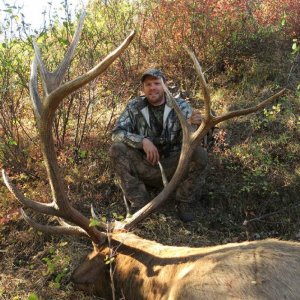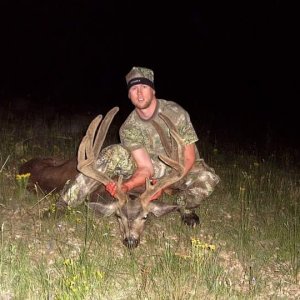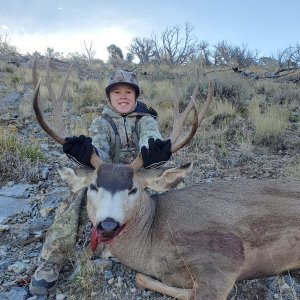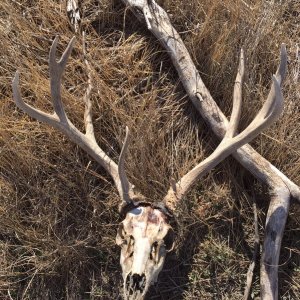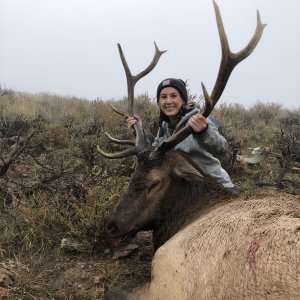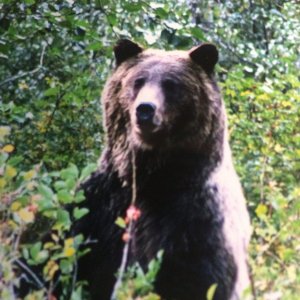Wow
This past Wednesday I shot a deer at long range --- 459 yards. My equipment includes a Tikka brand rifle in 7 mm Remington magnum with a Burris Signature model scope, 4 to 16 power variable. The rifle is fitted with an after-market Boss system made by Que Industries. The handloaded cartridge consists of the 120 grain Barnes "X" bullet at 3,500 feet per second. Sighted in at 300 yards for zero, the drop at 459 yards is about 12 inches from line of sight. I use a Bushnell Lytespeed lazer rangefinder --- the new 800 yard model. My bullet drops about one inch every 10 yards at this distance. To hunt responsibly at long range you must know the distance precisely.
I practice shooting out to 400 yards and 500 yards. My normal 3 shot groups at 100 yards measure just under one inch. My best-ever 400 yard group with this combo was 3 shots in 1.1 inches --- never came that close again, though. I watch the effects of wind and don't even bother shooting if there is much velocity at all. A ten-mph cross wind causes 10 inches of bullet drift at 400 yards.
This past Wednesday was 5 days into the Wisconsin gun season for Whitetails. Bucks, normally fairly nocturnal, are even more so after 5 days of loud shooting. I had seen this 10 point buck with its 18 inch inside spread congregating with a group of bachelor bucks in the hayfields in July and early August. I also saw him 5 or 6 times during the bow season. This two or three year old buck field-dressed at 175 pounds and represents the oldest, largest, most savvy prey that we usually are challenged by in my heavily hunted neighborhood.
My closest earlier hunting encounter with him was on my first evening out during the bow season. Forty-five minutes before closing time, a nice 13 1/2 inch yearling (which my son later shot thinking it was a 2 year old) led him out of the marsh to within 35 yards of my stand. With the yearling standing relaxed and broadside at a shootable distance, I waited for his older friend to move forward just 2 yards --- out from behind some brush. No luck that night and I never got that close again. He was very wary. I saw him several more times during the bow season and twice during the gun season.
The wind was about 3 to 5 mph, quartering from about 2 o'clock. Visibility was good with clouds above. My treestand put me about 30 feet above ground and my stand's safety-rail/armrest gave me near-benchrest stability.
My stand is in a white pine tree where one side of the marsh meets a small woods. A few evenings earlier from this stand I had watched 2 small yearlings chasing a doe just 60 yards out from me. Now, while still dark out, I had been forced to cough once and worried about what that did to my chances for the morning. A few minutes later I had heard one deer crash into the woods, going away from me. In this stand I could expect a shot at a deer as close as 30 yards or as far away as ...
I used my Zeiss 10 x 56 Night-owl binoculars to glass the marsh even before there was good shooting light, hoping to see my pre-selected buck heading home to his bedroom just before dawn. Discovering where he was settling down would give me the patience to wait for him to stand up and expose himself in his "safe" bedding area sometime during the upcoming day. He wouldn't expect danger from 30 feet up and perhaps a quarter mile away.
Dawn came and I still had not seen him. The time was now about 6:50 am, 15 minutes after the start of legal shooting time. Then I glassed again in the area across the marsh where I'd seen him briefly Sunday, just before dark.
Now I saw a large deer chasing a smaller one. The smaller deer left my view. Upon further study, I could see that that the larger remaining deer was my quarry. A range of nearly 500 yards --- and in early morning light --- is a little tough for a first-time, accurate trophy analysis. But I was familiar with this deer and most of the other bucks in the area and was confident in my identification of it. So far, my hours spent in the field this year totaled nearly one hundred --- hunting deer during the bow and rifle seasons.
My Lytespeed rangefinder told me the distance was 459 yards. The buck was now relaxed and standing still as the crosshairs in my 16 power scope settled in just above his back. At the first shot he stood fairly still, moving his head around a little. A deer shot at this range does not always react with immediate flight like one shot at 50 or 100 yards.
I was fairly confident that I had hit him well. I thought I had actually heard the bullet impact but I am not sure it is possible at that distance. In the video of my 65 inch Alaskan moose hunt (available in the Cabela?s catalog), shot earlier this fall, the sound of the bullet impact is readily heard, but that was at only 150 yards.
I fired again and after recovery from the recoil of my follow-up shot, my scope could not pick up the buck again in the tall grass. I then glassed the area with my binoculars for 15 minutes and mentally marked the site. Then I got down and took the 1/2 mile roundabout trail across the marsh, trying to relax and enjoy the morning as I walked.
Though confident, I knew I could also be wrong. Could have missed him. Could be the wrong deer. Could have just wounded him. I approached the site from uphill and upwind so he would run into the open marsh if he could run at all. But there he was--- not one step from where he had stood when I fired! Both had been killing shots.
This was a very satisfying conclusion to a wonderful hunting year! I share it with you fellow hunters for the purpose of hearing from other responsible long-range hunters who practice at long range and use the equipment and disciplined methods required for humanely taking game at long distances.
I am looking for a friendly, productive discussion from newsgroup members (or personal e-mail). So --- for you naysayers who probably haven't even noticed the degree of my preparation and care --- please hold your comments to yourself.
Now I saw a large deer chasing a smaller one. The smaller deer left my view. Upon further study, I could see that that the larger remaining deer was my quarry. A range of nearly 500 yards --- and in early morning light --- is a little tough for a first-time, accurate trophy analysis. But I was familiar with this deer and most of the other bucks in the area and was confident in my identification of it. So far, my hours spent in the field this year totaled nearly one hundred --- hunting deer during the bow and rifle seasons.
My Lytespeed rangefinder told me the distance was 459 yards. The buck was now relaxed and standing still as the crosshairs in my 16 power scope settled in just above his back. At the first shot he stood fairly still, moving his head around a little. A deer shot at this range does not always react with immediate flight like one shot at 50 or 100 yards.
I was fairly confident that I had hit him well. I thought I had actually heard the bullet impact but I am not sure it is possible at that distance. In the video of my 65 inch Alaskan moose hunt (available in the Cabela?s catalog), shot earlier this fall, the sound of the bullet impact is readily heard, but that was at only 150 yards.
I fired again and after recovery from the recoil of my follow-up shot, my scope could not pick up the buck again in the tall grass. I then glassed the area with my binoculars for 15 minutes and mentally marked the site. Then I got down and took the 1/2 mile roundabout trail across the marsh, trying to relax and enjoy the morning as I walked.
Though confident, I knew I could also be wrong. Could have missed him. Could be the wrong deer. Could have just wounded him. I approached the site from uphill and upwind so he would run into the open marsh if he could run at all. But there he was--- not one step from where he had stood when I fired! Both had been killing shots.
This was a very satisfying conclusion to a wonderful hunting year! I share it with you fellow hunters for the purpose of hearing from other responsible long-range hunters who practice at long range and use the equipment and disciplined methods required for humanely taking game at long distances.
I am looking for a friendly, productive discussion from newsgroup members (or personal e-mail). So --- for you naysayers who probably haven't even noticed the degree of my preparation and care --- please hold your comments to yourself.
Now I saw a large deer chasing a smaller one. The smaller deer left my view. Upon further study, I could see that that the larger remaining deer was my quarry. A range of nearly 500 yards --- and in early morning light --- is a little tough for a first-time, accurate trophy analysis. But I was familiar with this deer and most of the other bucks in the area and was confident in my identification of it. So far, my hours spent in the field this year totaled nearly one hundred --- hunting deer during the bow and rifle seasons.
My Lytespeed rangefinder told me the distance was 459 yards. The buck was now relaxed and standing still as the crosshairs in my 16 power scope settled in just above his back. At the first shot he stood fairly still, moving his head around a little. A deer shot at this range does not always react with immediate flight like one shot at 50 or 100 yards.
I was fairly confident that I had hit him well. I thought I had actually heard the bullet impact but I am not sure it is possible at that distance. In the video of my 65 inch Alaskan moose hunt (available in the Cabela?s catalog), shot earlier this fall, the sound of the bullet impact is readily heard, but that was at only 150 yards.
I fired again and after recovery from the recoil of my follow-up shot, my scope could not pick up the buck again in the tall grass. I then glassed the area with my binoculars for 15 minutes and mentally marked the site. Then I got down and took the 1/2 mile roundabout trail across the marsh, trying to relax and enjoy the morning as I walked.
Though confident, I knew I could also be wrong. Could have missed him. Could be the wrong deer. Could have just wounded him. I approached the site from uphill and upwind so he would run into the open marsh if he could run at all. But there he was--- not one step from where he had stood when I fired! Both had been killing shots.
This was a very satisfying conclusion to a wonderful hunting year! I share it with you fellow hunters for the purpose of hearing from other responsible long-range hunters who practice at long range and use the equipment and disciplined methods required for humanely taking game at long distances.
I am looking for a friendly, productive discussion from newsgroup members (or personal e-mail). So --- for you naysayers who probably haven't even noticed the degree of my preparation and care --- please hold your comments to yourself.
This past Wednesday I shot a deer at long range --- 459 yards. My equipment includes a Tikka brand rifle in 7 mm Remington magnum with a Burris Signature model scope, 4 to 16 power variable. The rifle is fitted with an after-market Boss system made by Que Industries. The handloaded cartridge consists of the 120 grain Barnes "X" bullet at 3,500 feet per second. Sighted in at 300 yards for zero, the drop at 459 yards is about 12 inches from line of sight. I use a Bushnell Lytespeed lazer rangefinder --- the new 800 yard model. My bullet drops about one inch every 10 yards at this distance. To hunt responsibly at long range you must know the distance precisely.
I practice shooting out to 400 yards and 500 yards. My normal 3 shot groups at 100 yards measure just under one inch. My best-ever 400 yard group with this combo was 3 shots in 1.1 inches --- never came that close again, though. I watch the effects of wind and don't even bother shooting if there is much velocity at all. A ten-mph cross wind causes 10 inches of bullet drift at 400 yards.
This past Wednesday was 5 days into the Wisconsin gun season for Whitetails. Bucks, normally fairly nocturnal, are even more so after 5 days of loud shooting. I had seen this 10 point buck with its 18 inch inside spread congregating with a group of bachelor bucks in the hayfields in July and early August. I also saw him 5 or 6 times during the bow season. This two or three year old buck field-dressed at 175 pounds and represents the oldest, largest, most savvy prey that we usually are challenged by in my heavily hunted neighborhood.
My closest earlier hunting encounter with him was on my first evening out during the bow season. Forty-five minutes before closing time, a nice 13 1/2 inch yearling (which my son later shot thinking it was a 2 year old) led him out of the marsh to within 35 yards of my stand. With the yearling standing relaxed and broadside at a shootable distance, I waited for his older friend to move forward just 2 yards --- out from behind some brush. No luck that night and I never got that close again. He was very wary. I saw him several more times during the bow season and twice during the gun season.
The wind was about 3 to 5 mph, quartering from about 2 o'clock. Visibility was good with clouds above. My treestand put me about 30 feet above ground and my stand's safety-rail/armrest gave me near-benchrest stability.
My stand is in a white pine tree where one side of the marsh meets a small woods. A few evenings earlier from this stand I had watched 2 small yearlings chasing a doe just 60 yards out from me. Now, while still dark out, I had been forced to cough once and worried about what that did to my chances for the morning. A few minutes later I had heard one deer crash into the woods, going away from me. In this stand I could expect a shot at a deer as close as 30 yards or as far away as ...
I used my Zeiss 10 x 56 Night-owl binoculars to glass the marsh even before there was good shooting light, hoping to see my pre-selected buck heading home to his bedroom just before dawn. Discovering where he was settling down would give me the patience to wait for him to stand up and expose himself in his "safe" bedding area sometime during the upcoming day. He wouldn't expect danger from 30 feet up and perhaps a quarter mile away.
Dawn came and I still had not seen him. The time was now about 6:50 am, 15 minutes after the start of legal shooting time. Then I glassed again in the area across the marsh where I'd seen him briefly Sunday, just before dark.
Now I saw a large deer chasing a smaller one. The smaller deer left my view. Upon further study, I could see that that the larger remaining deer was my quarry. A range of nearly 500 yards --- and in early morning light --- is a little tough for a first-time, accurate trophy analysis. But I was familiar with this deer and most of the other bucks in the area and was confident in my identification of it. So far, my hours spent in the field this year totaled nearly one hundred --- hunting deer during the bow and rifle seasons.
My Lytespeed rangefinder told me the distance was 459 yards. The buck was now relaxed and standing still as the crosshairs in my 16 power scope settled in just above his back. At the first shot he stood fairly still, moving his head around a little. A deer shot at this range does not always react with immediate flight like one shot at 50 or 100 yards.
I was fairly confident that I had hit him well. I thought I had actually heard the bullet impact but I am not sure it is possible at that distance. In the video of my 65 inch Alaskan moose hunt (available in the Cabela?s catalog), shot earlier this fall, the sound of the bullet impact is readily heard, but that was at only 150 yards.
I fired again and after recovery from the recoil of my follow-up shot, my scope could not pick up the buck again in the tall grass. I then glassed the area with my binoculars for 15 minutes and mentally marked the site. Then I got down and took the 1/2 mile roundabout trail across the marsh, trying to relax and enjoy the morning as I walked.
Though confident, I knew I could also be wrong. Could have missed him. Could be the wrong deer. Could have just wounded him. I approached the site from uphill and upwind so he would run into the open marsh if he could run at all. But there he was--- not one step from where he had stood when I fired! Both had been killing shots.
This was a very satisfying conclusion to a wonderful hunting year! I share it with you fellow hunters for the purpose of hearing from other responsible long-range hunters who practice at long range and use the equipment and disciplined methods required for humanely taking game at long distances.
I am looking for a friendly, productive discussion from newsgroup members (or personal e-mail). So --- for you naysayers who probably haven't even noticed the degree of my preparation and care --- please hold your comments to yourself.
Now I saw a large deer chasing a smaller one. The smaller deer left my view. Upon further study, I could see that that the larger remaining deer was my quarry. A range of nearly 500 yards --- and in early morning light --- is a little tough for a first-time, accurate trophy analysis. But I was familiar with this deer and most of the other bucks in the area and was confident in my identification of it. So far, my hours spent in the field this year totaled nearly one hundred --- hunting deer during the bow and rifle seasons.
My Lytespeed rangefinder told me the distance was 459 yards. The buck was now relaxed and standing still as the crosshairs in my 16 power scope settled in just above his back. At the first shot he stood fairly still, moving his head around a little. A deer shot at this range does not always react with immediate flight like one shot at 50 or 100 yards.
I was fairly confident that I had hit him well. I thought I had actually heard the bullet impact but I am not sure it is possible at that distance. In the video of my 65 inch Alaskan moose hunt (available in the Cabela?s catalog), shot earlier this fall, the sound of the bullet impact is readily heard, but that was at only 150 yards.
I fired again and after recovery from the recoil of my follow-up shot, my scope could not pick up the buck again in the tall grass. I then glassed the area with my binoculars for 15 minutes and mentally marked the site. Then I got down and took the 1/2 mile roundabout trail across the marsh, trying to relax and enjoy the morning as I walked.
Though confident, I knew I could also be wrong. Could have missed him. Could be the wrong deer. Could have just wounded him. I approached the site from uphill and upwind so he would run into the open marsh if he could run at all. But there he was--- not one step from where he had stood when I fired! Both had been killing shots.
This was a very satisfying conclusion to a wonderful hunting year! I share it with you fellow hunters for the purpose of hearing from other responsible long-range hunters who practice at long range and use the equipment and disciplined methods required for humanely taking game at long distances.
I am looking for a friendly, productive discussion from newsgroup members (or personal e-mail). So --- for you naysayers who probably haven't even noticed the degree of my preparation and care --- please hold your comments to yourself.
Now I saw a large deer chasing a smaller one. The smaller deer left my view. Upon further study, I could see that that the larger remaining deer was my quarry. A range of nearly 500 yards --- and in early morning light --- is a little tough for a first-time, accurate trophy analysis. But I was familiar with this deer and most of the other bucks in the area and was confident in my identification of it. So far, my hours spent in the field this year totaled nearly one hundred --- hunting deer during the bow and rifle seasons.
My Lytespeed rangefinder told me the distance was 459 yards. The buck was now relaxed and standing still as the crosshairs in my 16 power scope settled in just above his back. At the first shot he stood fairly still, moving his head around a little. A deer shot at this range does not always react with immediate flight like one shot at 50 or 100 yards.
I was fairly confident that I had hit him well. I thought I had actually heard the bullet impact but I am not sure it is possible at that distance. In the video of my 65 inch Alaskan moose hunt (available in the Cabela?s catalog), shot earlier this fall, the sound of the bullet impact is readily heard, but that was at only 150 yards.
I fired again and after recovery from the recoil of my follow-up shot, my scope could not pick up the buck again in the tall grass. I then glassed the area with my binoculars for 15 minutes and mentally marked the site. Then I got down and took the 1/2 mile roundabout trail across the marsh, trying to relax and enjoy the morning as I walked.
Though confident, I knew I could also be wrong. Could have missed him. Could be the wrong deer. Could have just wounded him. I approached the site from uphill and upwind so he would run into the open marsh if he could run at all. But there he was--- not one step from where he had stood when I fired! Both had been killing shots.
This was a very satisfying conclusion to a wonderful hunting year! I share it with you fellow hunters for the purpose of hearing from other responsible long-range hunters who practice at long range and use the equipment and disciplined methods required for humanely taking game at long distances.
I am looking for a friendly, productive discussion from newsgroup members (or personal e-mail). So --- for you naysayers who probably haven't even noticed the degree of my preparation and care --- please hold your comments to yourself.
This past Wednesday I shot a deer at long range --- 459 yards. My equipment includes a Tikka brand rifle in 7 mm Remington magnum with a Burris Signature model scope, 4 to 16 power variable. The rifle is fitted with an after-market Boss system made by Que Industries. The handloaded cartridge consists of the 120 grain Barnes "X" bullet at 3,500 feet per second. Sighted in at 300 yards for zero, the drop at 459 yards is about 12 inches from line of sight. I use a Bushnell Lytespeed lazer rangefinder --- the new 800 yard model. My bullet drops about one inch every 10 yards at this distance. To hunt responsibly at long range you must know the distance precisely.
I practice shooting out to 400 yards and 500 yards. My normal 3 shot groups at 100 yards measure just under one inch. My best-ever 400 yard group with this combo was 3 shots in 1.1 inches --- never came that close again, though. I watch the effects of wind and don't even bother shooting if there is much velocity at all. A ten-mph cross wind causes 10 inches of bullet drift at 400 yards.
This past Wednesday was 5 days into the Wisconsin gun season for Whitetails. Bucks, normally fairly nocturnal, are even more so after 5 days of loud shooting. I had seen this 10 point buck with its 18 inch inside spread congregating with a group of bachelor bucks in the hayfields in July and early August. I also saw him 5 or 6 times during the bow season. This two or three year old buck field-dressed at 175 pounds and represents the oldest, largest, most savvy prey that we usually are challenged by in my heavily hunted neighborhood.
My closest earlier hunting encounter with him was on my first evening out during the bow season. Forty-five minutes before closing time, a nice 13 1/2 inch yearling (which my son later shot thinking it was a 2 year old) led him out of the marsh to within 35 yards of my stand. With the yearling standing relaxed and broadside at a shootable distance, I waited for his older friend to move forward just 2 yards --- out from behind some brush. No luck that night and I never got that close again. He was very wary. I saw him several more times during the bow season and twice during the gun season.
The wind was about 3 to 5 mph, quartering from about 2 o'clock. Visibility was good with clouds above. My treestand put me about 30 feet above ground and my stand's safety-rail/armrest gave me near-benchrest stability.
My stand is in a white pine tree where one side of the marsh meets a small woods. A few evenings earlier from this stand I had watched 2 small yearlings chasing a doe just 60 yards out from me. Now, while still dark out, I had been forced to cough once and worried about what that did to my chances for the morning. A few minutes later I had heard one deer crash into the woods, going away from me. In this stand I could expect a shot at a deer as close as 30 yards or as far away as ...
I used my Zeiss 10 x 56 Night-owl binoculars to glass the marsh even before there was good shooting light, hoping to see my pre-selected buck heading home to his bedroom just before dawn. Discovering where he was settling down would give me the patience to wait for him to stand up and expose himself in his "safe" bedding area sometime during the upcoming day. He wouldn't expect danger from 30 feet up and perhaps a quarter mile away.
Dawn came and I still had not seen him. The time was now about 6:50 am, 15 minutes after the start of legal shooting time. Then I glassed again in the area across the marsh where I'd seen him briefly Sunday, just before dark.
Now I saw a large deer chasing a smaller one. The smaller deer left my view. Upon further study, I could see that that the larger remaining deer was my quarry. A range of nearly 500 yards --- and in early morning light --- is a little tough for a first-time, accurate trophy analysis. But I was familiar with this deer and most of the other bucks in the area and was confident in my identification of it. So far, my hours spent in the field this year totaled nearly one hundred --- hunting deer during the bow and rifle seasons.
My Lytespeed rangefinder told me the distance was 459 yards. The buck was now relaxed and standing still as the crosshairs in my 16 power scope settled in just above his back. At the first shot he stood fairly still, moving his head around a little. A deer shot at this range does not always react with immediate flight like one shot at 50 or 100 yards.
I was fairly confident that I had hit him well. I thought I had actually heard the bullet impact but I am not sure it is possible at that distance. In the video of my 65 inch Alaskan moose hunt (available in the Cabela?s catalog), shot earlier this fall, the sound of the bullet impact is readily heard, but that was at only 150 yards.
I fired again and after recovery from the recoil of my follow-up shot, my scope could not pick up the buck again in the tall grass. I then glassed the area with my binoculars for 15 minutes and mentally marked the site. Then I got down and took the 1/2 mile roundabout trail across the marsh, trying to relax and enjoy the morning as I walked.
Though confident, I knew I could also be wrong. Could have missed him. Could be the wrong deer. Could have just wounded him. I approached the site from uphill and upwind so he would run into the open marsh if he could run at all. But there he was--- not one step from where he had stood when I fired! Both had been killing shots.
This was a very satisfying conclusion to a wonderful hunting year! I share it with you fellow hunters for the purpose of hearing from other responsible long-range hunters who practice at long range and use the equipment and disciplined methods required for humanely taking game at long distances.
I am looking for a friendly, productive discussion from newsgroup members (or personal e-mail). So --- for you naysayers who probably haven't even noticed the degree of my preparation and care --- please hold your comments to yourself.
Now I saw a large deer chasing a smaller one. The smaller deer left my view. Upon further study, I could see that that the larger remaining deer was my quarry. A range of nearly 500 yards --- and in early morning light --- is a little tough for a first-time, accurate trophy analysis. But I was familiar with this deer and most of the other bucks in the area and was confident in my identification of it. So far, my hours spent in the field this year totaled nearly one hundred --- hunting deer during the bow and rifle seasons.
My Lytespeed rangefinder told me the distance was 459 yards. The buck was now relaxed and standing still as the crosshairs in my 16 power scope settled in just above his back. At the first shot he stood fairly still, moving his head around a little. A deer shot at this range does not always react with immediate flight like one shot at 50 or 100 yards.
I was fairly confident that I had hit him well. I thought I had actually heard the bullet impact but I am not sure it is possible at that distance. In the video of my 65 inch Alaskan moose hunt (available in the Cabela?s catalog), shot earlier this fall, the sound of the bullet impact is readily heard, but that was at only 150 yards.
I fired again and after recovery from the recoil of my follow-up shot, my scope could not pick up the buck again in the tall grass. I then glassed the area with my binoculars for 15 minutes and mentally marked the site. Then I got down and took the 1/2 mile roundabout trail across the marsh, trying to relax and enjoy the morning as I walked.
Though confident, I knew I could also be wrong. Could have missed him. Could be the wrong deer. Could have just wounded him. I approached the site from uphill and upwind so he would run into the open marsh if he could run at all. But there he was--- not one step from where he had stood when I fired! Both had been killing shots.
This was a very satisfying conclusion to a wonderful hunting year! I share it with you fellow hunters for the purpose of hearing from other responsible long-range hunters who practice at long range and use the equipment and disciplined methods required for humanely taking game at long distances.
I am looking for a friendly, productive discussion from newsgroup members (or personal e-mail). So --- for you naysayers who probably haven't even noticed the degree of my preparation and care --- please hold your comments to yourself.
Now I saw a large deer chasing a smaller one. The smaller deer left my view. Upon further study, I could see that that the larger remaining deer was my quarry. A range of nearly 500 yards --- and in early morning light --- is a little tough for a first-time, accurate trophy analysis. But I was familiar with this deer and most of the other bucks in the area and was confident in my identification of it. So far, my hours spent in the field this year totaled nearly one hundred --- hunting deer during the bow and rifle seasons.
My Lytespeed rangefinder told me the distance was 459 yards. The buck was now relaxed and standing still as the crosshairs in my 16 power scope settled in just above his back. At the first shot he stood fairly still, moving his head around a little. A deer shot at this range does not always react with immediate flight like one shot at 50 or 100 yards.
I was fairly confident that I had hit him well. I thought I had actually heard the bullet impact but I am not sure it is possible at that distance. In the video of my 65 inch Alaskan moose hunt (available in the Cabela?s catalog), shot earlier this fall, the sound of the bullet impact is readily heard, but that was at only 150 yards.
I fired again and after recovery from the recoil of my follow-up shot, my scope could not pick up the buck again in the tall grass. I then glassed the area with my binoculars for 15 minutes and mentally marked the site. Then I got down and took the 1/2 mile roundabout trail across the marsh, trying to relax and enjoy the morning as I walked.
Though confident, I knew I could also be wrong. Could have missed him. Could be the wrong deer. Could have just wounded him. I approached the site from uphill and upwind so he would run into the open marsh if he could run at all. But there he was--- not one step from where he had stood when I fired! Both had been killing shots.
This was a very satisfying conclusion to a wonderful hunting year! I share it with you fellow hunters for the purpose of hearing from other responsible long-range hunters who practice at long range and use the equipment and disciplined methods required for humanely taking game at long distances.
I am looking for a friendly, productive discussion from newsgroup members (or personal e-mail). So --- for you naysayers who probably haven't even noticed the degree of my preparation and care --- please hold your comments to yourself.
>This past Wednesday I shot a
>deer at long range ---
>459 yards. My equipment includes
>a Tikka brand rifle in
>7 mm Remington magnum with
>a Burris Signature model scope,
>4 to 16 power variable.
>The rifle is fitted with
>an after-market Boss system made
>by Que Industries. The handloaded
>cartridge consists of the 120
>grain Barnes "X" bullet at
>3,500 feet per second. Sighted
>in at 300 yards for
>zero, the drop at 459
>yards is about 12 inches
>from line of sight. I
>use a Bushnell Lytespeed lazer
>rangefinder --- the new 800
>yard model. My bullet drops
>about one inch every 10
>yards at this distance. To
>hunt responsibly at long range
>you must know the distance
>precisely.
>
>I practice shooting out to 400
>yards and 500 yards. My
>normal 3 shot groups at
>100 yards measure just under
>one inch. My best-ever 400
>yard group with this combo
>was 3 shots in 1.1
>inches --- never came that
>close again, though. I watch
>the effects of wind and
>don't even bother shooting if
>there is much velocity at
>all. A ten-mph cross wind
>causes 10 inches of bullet
>drift at 400 yards.
>
>This past Wednesday was 5 days
>into the Wisconsin gun season
>for Whitetails. Bucks, normally fairly
>nocturnal, are even more so
>after 5 days of loud
>shooting. I had seen this
>10 point buck with its
>18 inch inside spread congregating
>with a group of bachelor
>bucks in the hayfields in
>July and early August. I
>also saw him 5 or
>6 times during the bow
>season. This two or three
>year old buck field-dressed at
>175 pounds and represents the
>oldest, largest, most savvy prey
>that we usually are challenged
>by in my heavily hunted
>neighborhood.
>
>My closest earlier hunting encounter with
>him was on my first
>evening out during the bow
>season. Forty-five minutes before closing
>time, a nice 13 1/2
>inch yearling (which my son
>later shot thinking it was
>a 2 year old) led
>him out of the marsh
>to within 35 yards of
>my stand. With the yearling
>standing relaxed and broadside at
>a shootable distance, I waited
>for his older friend to
>move forward just 2 yards
>--- out from behind some
>brush. No luck that night
>and I never got that
>close again. He was very
>wary. I saw him several
>more times during the bow
>season and twice during the
>gun season.
>
>The wind was about 3 to
>5 mph, quartering from about
>2 o'clock. Visibility was good
>with clouds above. My treestand
>put me about 30 feet
>above ground and my stand's
>safety-rail/armrest gave me near-benchrest stability.
>
>
>
>
>My stand is in a white
>pine tree where one side
>of the marsh meets a
>small woods. A few evenings
>earlier from this stand I
>had watched 2 small yearlings
>chasing a doe just 60
>yards out from me. Now,
>while still dark out, I
>had been forced to cough
>once and worried about what
>that did to my chances
>for the morning. A few
>minutes later I had heard
>one deer crash into the
>woods, going away from me.
>In this stand I could
>expect a shot at a
>deer as close as 30
>yards or as far away
>as ...
>
>I used my Zeiss 10 x
>56 Night-owl binoculars to glass
>the marsh even before there
>was good shooting light, hoping
>to see my pre-selected buck
>heading home to his bedroom
>just before dawn. Discovering where
>he was settling down would
>give me the patience to
>wait for him to stand
>up and expose himself in
>his "safe" bedding area sometime
>during the upcoming day. He
>wouldn't expect danger from 30
>feet up and perhaps a
>quarter mile away.
>
>Dawn came and I still had
>not seen him. The time
>was now about 6:50 am,
>15 minutes after the start
>of legal shooting time. Then
>I glassed again in the
>area across the marsh where
>I'd seen him briefly Sunday,
>just before dark.
>
>Now I saw a large deer
>chasing a smaller one. The
>smaller deer left my view.
>Upon further study, I could
>see that that the larger
>remaining deer was my quarry.
>A range of nearly 500
>yards --- and in early
>morning light --- is a
>little tough for a first-time,
>accurate trophy analysis. But I
>was familiar with this deer
>and most of the other
>bucks in the area and
>was confident in my identification
>of it. So far, my
>hours spent in the field
>this year totaled nearly one
>hundred --- hunting deer during
>the bow and rifle seasons.
>
>
>My Lytespeed rangefinder told me the
>distance was 459 yards. The
>buck was now relaxed and
>standing still as the crosshairs
>in my 16 power scope
>settled in just above his
>back. At the first shot
>he stood fairly still, moving
>his head around a little.
>A deer shot at this
>range does not always react
>with immediate flight like one
>shot at 50 or 100
>yards.
>
>I was fairly confident that I
>had hit him well. I
>thought I had actually heard
>the bullet impact but I
>am not sure it is
>possible at that distance. In
>the video of my 65
>inch Alaskan moose hunt (available
>in the Cabela?s catalog), shot
>earlier this fall, the sound
>of the bullet impact is
>readily heard, but that was
>at only 150 yards.
>
>I fired again and after recovery
>from the recoil of my
>follow-up shot, my scope could
>not pick up the buck
>again in the tall grass.
>I then glassed the area
>with my binoculars for 15
>minutes and mentally marked the
>site. Then I got down
>and took the 1/2 mile
>roundabout trail across the marsh,
>trying to relax and enjoy
>the morning as I walked.
>
>
>Though confident, I knew I could
>also be wrong. Could have
>missed him. Could be the
>wrong deer. Could have just
>wounded him. I approached the
>site from uphill and upwind
>so he would run into
>the open marsh if he
>could run at all. But
>there he was--- not one
>step from where he had
>stood when I fired! Both
>had been killing shots.
>
>This was a very satisfying conclusion
>to a wonderful hunting year!
>I share it with you
>fellow hunters for the purpose
>of hearing from other responsible
>long-range hunters who practice at
>long range and use the
>equipment and disciplined methods required
>for humanely taking game at
>long distances.
>
>I am looking for a friendly,
>productive discussion from newsgroup members
>(or personal e-mail). So ---
>for you naysayers who probably
>haven't even noticed the degree
>of my preparation and care
>--- please hold your comments
>to yourself.
>
>Now I saw a large deer
>chasing a smaller one. The
>smaller deer left my view.
>Upon further study, I could
>see that that the larger
>remaining deer was my quarry.
>A range of nearly 500
>yards --- and in early
>morning light --- is a
>little tough for a first-time,
>accurate trophy analysis. But I
>was familiar with this deer
>and most of the other
>bucks in the area and
>was confident in my identification
>of it. So far, my
>hours spent in the field
>this year totaled nearly one
>hundred --- hunting deer during
>the bow and rifle seasons.
>
>
>My Lytespeed rangefinder told me the
>distance was 459 yards. The
>buck was now relaxed and
>standing still as the crosshairs
>in my 16 power scope
>settled in just above his
>back. At the first shot
>he stood fairly still, moving
>his head around a little.
>A deer shot at this
>range does not always react
>with immediate flight like one
>shot at 50 or 100
>yards.
>
>I was fairly confident that I
>had hit him well. I
>thought I had actually heard
>the bullet impact but I
>am not sure it is
>possible at that distance. In
>the video of my 65
>inch Alaskan moose hunt (available
>in the Cabela?s catalog), shot
>earlier this fall, the sound
>of the bullet impact is
>readily heard, but that was
>at only 150 yards.
>
>I fired again and after recovery
>from the recoil of my
>follow-up shot, my scope could
>not pick up the buck
>again in the tall grass.
>I then glassed the area
>with my binoculars for 15
>minutes and mentally marked the
>site. Then I got down
>and took the 1/2 mile
>roundabout trail across the marsh,
>trying to relax and enjoy
>the morning as I walked.
>
>
>Though confident, I knew I could
>also be wrong. Could have
>missed him. Could be the
>wrong deer. Could have just
>wounded him. I approached the
>site from uphill and upwind
>so he would run into
>the open marsh if he
>could run at all. But
>there he was--- not one
>step from where he had
>stood when I fired! Both
>had been killing shots.
>
>This was a very satisfying conclusion
>to a wonderful hunting year!
>I share it with you
>fellow hunters for the purpose
>of hearing from other responsible
>long-range hunters who practice at
>long range and use the
>equipment and disciplined methods required
>for humanely taking game at
>long distances.
>
>I am looking for a friendly,
>productive discussion from newsgroup members
>(or personal e-mail). So ---
>for you naysayers who probably
>haven't even noticed the degree
>of my preparation and care
>--- please hold your comments
>to yourself.
>
>Now I saw a large deer
>chasing a smaller one. The
>smaller deer left my view.
>Upon further study, I could
>see that that the larger
>remaining deer was my quarry.
>A range of nearly 500
>yards --- and in early
>morning light --- is a
>little tough for a first-time,
>accurate trophy analysis. But I
>was familiar with this deer
>and most of the other
>bucks in the area and
>was confident in my identification
>of it. So far, my
>hours spent in the field
>this year totaled nearly one
>hundred --- hunting deer during
>the bow and rifle seasons.
>
>
>My Lytespeed rangefinder told me the
>distance was 459 yards. The
>buck was now relaxed and
>standing still as the crosshairs
>in my 16 power scope
>settled in just above his
>back. At the first shot
>he stood fairly still, moving
>his head around a little.
>A deer shot at this
>range does not always react
>with immediate flight like one
>shot at 50 or 100
>yards.
>
>I was fairly confident that I
>had hit him well. I
>thought I had actually heard
>the bullet impact but I
>am not sure it is
>possible at that distance. In
>the video of my 65
>inch Alaskan moose hunt (available
>in the Cabela?s catalog), shot
>earlier this fall, the sound
>of the bullet impact is
>readily heard, but that was
>at only 150 yards.
>
>I fired again and after recovery
>from the recoil of my
>follow-up shot, my scope could
>not pick up the buck
>again in the tall grass.
>I then glassed the area
>with my binoculars for 15
>minutes and mentally marked the
>site. Then I got down
>and took the 1/2 mile
>roundabout trail across the marsh,
>trying to relax and enjoy
>the morning as I walked.
>
>
>Though confident, I knew I could
>also be wrong. Could have
>missed him. Could be the
>wrong deer. Could have just
>wounded him. I approached the
>site from uphill and upwind
>so he would run into
>the open marsh if he
>could run at all. But
>there he was--- not one
>step from where he had
>stood when I fired! Both
>had been killing shots.
>
>This was a very satisfying conclusion
>to a wonderful hunting year!
>I share it with you
>fellow hunters for the purpose
>of hearing from other responsible
>long-range hunters who practice at
>long range and use the
>equipment and disciplined methods required
>for humanely taking game at
>long distances.
>
>I am looking for a friendly,
>productive discussion from newsgroup members
>(or personal e-mail). So ---
>for you naysayers who probably
>haven't even noticed the degree
>of my preparation and care
>--- please hold your comments
>to yourself.
>
>Len Backus
Hot Dog,Hot Damn,I love this Ameri-can





